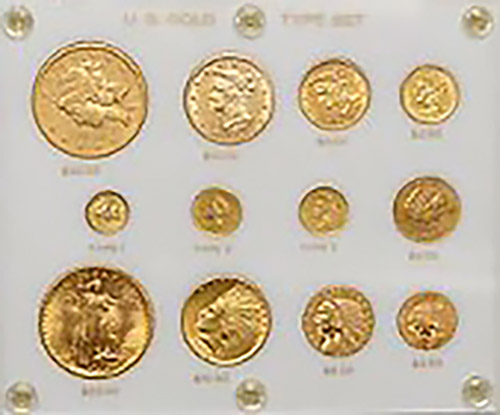Shore Collectibles
By Douglas Keefe, President of Beachcomber Coins
Gold coins were not struck by the Philadelphia Mint until 1795, and not until most of the lower denomination coins, from the half cent to the dollar were done. This was because the lower denomination coins were needed for day to day purchase. The high value gold coins were only needed for expensive purchases. They were not needed by the average person. The first gold coin to be struck was the $5 coin or half eagle in 1795, followed by the $2 1/2 coin, or quarter eagle in 1796. Several different designs were used in the early days, but since the demand and need for these coins was low, their mintage figures were also low, making these early coins rare and rather expensive.
In 1838 a $10 gold coin was created, an eagle, whose design featured the bust of Lady Liberty looking left on the front, and an eagle with spread wings on the reverse. The $2 ½ was redesigned in the style of the new $10 gold coin in 1839, and the $5 coin utilized the new design in 1840.
A $1 gold coin was introduced in 1849 a denomination that lasted until 1889, followed in 1850 by the introduction of a $20 gold coin, the double eagle, whose design mimicked that of the $2 ½, $5 and $10 coins on the front with a different eagle on the reverse. In 1854 a $3 gold coin was introduced, but it too had a short life just like the $1 coin; its’ mintage also ended in 1889.
So what would be a good choice for a gold type set? As I said, the early gold is expensive and not typically considered. So, most collectors focus on the coins from the years 1840 forward. Gold coins were minted until 1929 and 1933, with the need for gold coins disappearing due to the Depression and finally the banning of ownership of gold coins by President Franklin Roosevelt. Therefore, a basic gold type set would contain 1 each of all denomination from 1840 to the end of gold coins and would include the different designs used. A basic gold type set may include:
$1 gold coins: Liberty head style, (1849-1854); small Indian head (1854-1856); large Indian head (1856-1889)
$2 ½ gold coins: Liberty head sty[e, (1840-1907); Indian head (1908-1929)
$3 gold coin: Indian head (1854-1889)
$5 gold coin: Liberty Head (1840-1907); Indian head (1908-1929)
$10 gold coin: Liberty head (1840-1907); Indian head (1907-1933)
$20 gold coin: Liberty head (1850-1907); Standing Liberty (1907-1933*)
Another interesting set that can be built with gold coins is a mint set, that is a coin from every mint that struck gold coins. The Liberty head series of $5, $10 and $20 gold coins were all struck at various times at the Philadelphia, San Francisco, New Orleans, Carson City and Denver mints. That would be interesting to choose one or all of those denominations in the set.
Coin collecting should be personal, meant to satisfy the collector by collecting or accumulating what makes him or her happy. So, any choice to build a type set of gold coins is the right choice.
*In 1933, 445,500 $20 gold coins were struck by the Philadelphia mint. Due to Roosevelts decree that all gold coins should be returned to the government, the entire mintage was to be melted. Somehow some escaped that fate, but only one 1933 $20 gold coin resided in private hands.
Douglas Keefe is the President of Beachcomber Coins, Inc. He and his wife Linda operate Beachcomber Coins and Collectibles, formally located in the Shore Mall and now located at 6692 Black Horse Pike, Egg Harbor Township in the old Wawa building. They also have satellite offices for buying only in Brigantine (Saturday). Between them, they have over 70 years of experience buying and selling coins, collectibles in precious metals.






